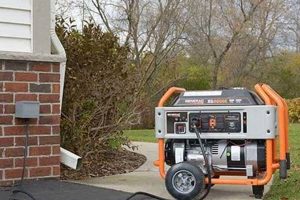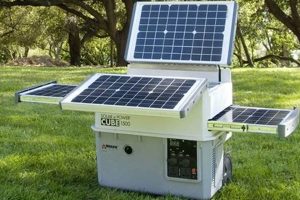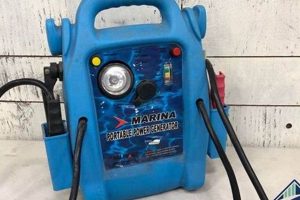A compact, self-contained unit harnesses sunlight to produce electricity, offering off-grid power for various applications. These devices typically consist of photovoltaic panels, a battery for energy storage, and an inverter to convert the stored direct current (DC) electricity into usable alternating current (AC) electricity. Imagine powering essential appliances during a camping trip or providing backup electricity during a power outage this is the practicality offered by these units.
The ability to generate electricity without relying on fossil fuels or a connection to the power grid presents significant advantages. This technology promotes energy independence, reduces carbon emissions, and offers a quiet, sustainable power source. Furthermore, advancements in battery technology and solar panel efficiency have made these devices increasingly practical and affordable, contributing to their growing popularity as a reliable alternative power solution. The increasing need for emergency preparedness and the desire for sustainable living have further driven the adoption of this technology.
This discussion will further explore key aspects such as sizing considerations, maintenance requirements, different types of available units, and potential applications, providing a comprehensive understanding of this versatile power solution. Additionally, the evolving landscape of this technology and its future potential will be examined.
Tips for Utilizing Portable Solar Generators
Effective use of portable solar generators requires understanding their capabilities and limitations. The following tips offer guidance for maximizing performance and longevity.
Tip 1: Accurate Power Needs Assessment: Calculate the total wattage required to run the intended devices. This ensures the chosen unit provides sufficient power output.
Tip 2: Optimal Solar Panel Positioning: Place solar panels in direct sunlight, facing south (in the Northern Hemisphere) for maximum solar energy absorption. Regularly adjust panel angle throughout the day to follow the sun’s path.
Tip 3: Consistent Battery Maintenance: Regularly charge the battery, even when not in use, to maintain its health and prolong its lifespan. Avoid completely depleting the battery, as this can shorten its lifespan.
Tip 4: Understanding Inverter Capacity: The inverter converts DC power to AC power. Ensure the inverter’s wattage rating exceeds the combined wattage of the devices to be powered simultaneously.
Tip 5: Weather Considerations: Extreme temperatures can impact battery performance and solar panel efficiency. Protect the unit from extreme weather conditions whenever possible.
Tip 6: Proper Storage: When not in use, store the generator in a cool, dry place away from direct sunlight. Partially charge the battery every few months during long-term storage.
Tip 7: Safety Precautions: Operate the generator in a well-ventilated area. Avoid overloading the unit, which can lead to overheating and potential damage.
By following these guidelines, users can ensure optimal performance, maximize the lifespan of their portable solar generator, and enjoy reliable, sustainable power whenever and wherever it’s needed.
These practical tips pave the way for a seamless transition towards greater energy independence and preparedness.
1. Portable Power Source
The concept of a portable power source is central to understanding the value of a solar-powered portable generator. These devices represent a significant advancement in power generation, offering a flexible and independent source of electricity wherever needed. This section explores the multifaceted nature of portable power and its implications.
- Convenience and Accessibility
Traditional generators often rely on gasoline, requiring a continuous supply of fuel and producing noise and emissions. A solar-powered portable generator eliminates these constraints, offering a quiet and clean power source that can be readily deployed. Imagine providing power for a remote worksite or a weekend camping trip. The portability of these units allows for convenient access to electricity in locations where traditional power sources are unavailable or impractical. This accessibility expands the possibilities for work and leisure activities.
- Emergency Preparedness
Natural disasters or unexpected power outages can disrupt daily life and compromise safety. A solar-powered portable generator provides a crucial backup power source for essential appliances and devices. For example, during a power outage, it can power refrigerators to preserve food, medical equipment to maintain essential life support, or communication devices to stay connected with emergency services. This preparedness enhances resilience in the face of unforeseen events.
- Environmental Responsibility
Conventional generators contribute to air and noise pollution. Solar-powered portable generators offer a clean and sustainable alternative, reducing reliance on fossil fuels and minimizing environmental impact. This aligns with a growing awareness of environmental responsibility and the need for sustainable energy solutions. By utilizing solar energy, these generators contribute to a cleaner and healthier environment.
- Economic Benefits
While the initial investment in a solar-powered portable generator might be higher than that of a traditional generator, the long-term cost savings are significant. Eliminating the ongoing expense of gasoline and reducing maintenance requirements contribute to substantial cost savings over the lifespan of the unit. This long-term economic advantage makes these generators an attractive investment.
These facets of portable power converge in the solar-powered portable generator, creating a versatile and practical solution for a variety of applications. From enhancing recreational activities to providing essential power during emergencies, these devices empower users with energy independence and contribute to a more sustainable future. The evolution of battery technology and solar panel efficiency continues to improve the capabilities and affordability of these generators, making them an increasingly viable option for a wide range of users.
2. Renewable Energy
Renewable energy sources, crucial for mitigating climate change and ensuring energy security, form the foundation of solar-powered portable generator technology. Harnessing sunlight, a perpetually available resource, positions these generators as a key component of a sustainable energy future. This section explores the multifaceted relationship between renewable energy and these devices.
- Reduced Reliance on Fossil Fuels
Traditional generators depend on finite fossil fuels, contributing to greenhouse gas emissions and air pollution. Solar-powered portable generators offer a clean alternative, reducing dependence on these environmentally damaging resources. This shift towards renewable energy sources aligns with global efforts to mitigate climate change and promote a healthier environment. For instance, disaster relief efforts can utilize these generators to power critical infrastructure without exacerbating air quality issues in affected areas.
- Energy Independence and Security
Renewable energy empowers individuals and communities with energy independence. Solar-powered portable generators provide a self-sufficient power source, reducing reliance on centralized power grids. This independence is particularly valuable in remote locations or during grid failures, offering a reliable power solution. Consider a rural community without access to the main power grid; these generators can provide essential electricity for homes, schools, and businesses, fostering self-sufficiency and economic development.
- Environmental Stewardship
Utilizing solar energy minimizes environmental impact. Unlike fossil fuel-based generators, solar-powered units produce no emissions during operation, preserving air and water quality. This commitment to environmental stewardship aligns with sustainable development goals and promotes a healthier planet. For example, using these generators in national parks minimizes the environmental footprint of visitors, preserving the natural beauty and ecological balance of these protected areas.
- Long-Term Cost Savings
While the initial investment in a solar-powered portable generator may be higher, the long-term cost benefits are significant. Eliminating fuel costs and reducing maintenance requirements translate into substantial savings over the generator’s lifespan. This economic advantage further strengthens the case for adopting renewable energy solutions. For homeowners, these generators can offset electricity bills, providing a return on investment while contributing to a greener lifestyle.
The convergence of renewable energy principles and portable generator technology creates a powerful solution for sustainable power generation. These devices empower users with energy independence, reduce environmental impact, and offer long-term cost savings. As solar panel technology continues to advance and battery storage capacity increases, solar-powered portable generators will play an increasingly vital role in the transition towards a cleaner and more sustainable energy future. Their versatility and adaptability make them a compelling alternative to traditional power sources, paving the way for a more resilient and environmentally responsible approach to energy consumption.
3. Emergency Preparedness
Emergency preparedness necessitates reliable access to power, especially when conventional sources are disrupted. Solar-powered portable generators offer a crucial solution, providing essential electricity during unforeseen events. This connection between emergency preparedness and these devices warrants detailed exploration.
- Power Outages
Power outages, whether caused by natural disasters or grid failures, can disrupt essential services and create safety hazards. A solar-powered portable generator ensures continued operation of critical appliances like refrigerators, medical devices, and communication systems. During a hurricane, for instance, these generators can power essential equipment, maintaining vital communication lines and providing life-saving support. This capability bridges the gap during power disruptions, minimizing disruption and enhancing safety.
- Natural Disasters
Natural disasters often leave communities without access to electricity. Solar-powered portable generators offer a readily deployable power source for emergency response and recovery efforts. Following an earthquake, for example, these generators can power temporary shelters, medical facilities, and communication hubs, facilitating rescue operations and providing essential services to affected populations. Their portability and independence from the grid make them invaluable in disaster-stricken areas.
- Evacuations
During evacuations, access to power can be critical for maintaining communication, powering navigation devices, and ensuring access to essential information. Solar-powered portable generators provide a reliable power source during transit and at temporary relocation sites. For individuals evacuating from a wildfire, these generators can power devices that provide real-time updates on evacuation routes and emergency instructions. This access to power enhances safety and facilitates effective evacuation procedures.
- Remote Locations
In remote areas with limited or no access to the power grid, solar-powered portable generators provide a vital source of electricity for essential needs. For medical teams operating in remote areas, these generators can power medical equipment, enabling critical care delivery in underserved communities. This capability extends the reach of essential services and enhances community resilience in remote locations.
The ability of solar-powered portable generators to provide reliable power during emergencies underscores their crucial role in preparedness strategies. These devices empower individuals, communities, and emergency response teams to maintain essential services, enhance safety, and navigate challenging situations with greater resilience. The increasing frequency and intensity of extreme weather events and the potential for grid disruptions further emphasize the importance of incorporating these generators into comprehensive emergency preparedness plans. Their versatility, sustainability, and independence from traditional power infrastructure position them as a valuable asset in mitigating the impact of unforeseen events and fostering greater community resilience.
4. Off-Grid Capabilities
Off-grid living, often associated with remote locations and self-sufficiency, gains practical feasibility through technologies like solar-powered portable generators. These devices provide a reliable and sustainable power source independent of traditional power grids, opening up new possibilities for work, leisure, and emergency preparedness. This section explores the facets of off-grid capabilities enabled by these generators.
- Remote Power Supply
Locations far from established power grids, such as remote cabins, research stations, or construction sites, often rely on noisy and polluting gasoline generators. Solar-powered portable generators offer a quiet, clean alternative, providing reliable electricity for essential operations. Imagine powering a remote weather monitoring station or providing electricity for a construction team building a trail in a wilderness area. These generators facilitate operations in remote areas without the logistical challenges and environmental impact of traditional fuel-based solutions.
- Recreational Activities
Camping, boating, and other outdoor recreational activities benefit significantly from portable power. Solar-powered generators allow enthusiasts to enjoy modern conveniences like lighting, refrigeration, and electronic devices without the noise and emissions of conventional generators. Consider a family camping trip in a national park; these generators can power small appliances and provide light without disrupting the natural environment. This capability enhances the enjoyment of outdoor activities while minimizing environmental impact.
- Emergency Preparedness and Disaster Relief
During natural disasters or other emergencies that disrupt power grids, solar-powered portable generators become invaluable. They can power essential communication equipment, medical devices, and other critical systems, ensuring continued operation during times of crisis. In the aftermath of a hurricane, for instance, these generators can power temporary shelters and medical facilities, providing essential support to affected communities. This capability enhances resilience and facilitates recovery efforts in the face of unforeseen events.
- Sustainable Living and Reduced Environmental Impact
Off-grid living often aligns with a commitment to sustainability. Solar-powered portable generators support this lifestyle by providing a clean and renewable energy source. By reducing reliance on fossil fuels, these generators minimize environmental impact and contribute to a cleaner, healthier planet. Homesteaders or individuals living in eco-friendly communities can utilize these generators to power their homes, reducing their carbon footprint and promoting sustainable living practices. This aligns with a growing global awareness of the need for environmentally responsible energy solutions.
The off-grid capabilities provided by solar-powered portable generators empower individuals and communities with energy independence and open up new possibilities for work, leisure, and emergency preparedness. By offering a clean, quiet, and sustainable power source, these generators contribute to a more resilient and environmentally responsible approach to energy consumption. As technology advances and battery storage capacity increases, the practicality and accessibility of off-grid living continue to expand, paving the way for a more sustainable and self-sufficient future.
5. Sustainable Solution
Sustainability, a core principle of responsible energy consumption, finds a practical application in solar-powered portable generators. These devices offer a viable alternative to traditional fossil fuel-powered generators, mitigating environmental impact while providing reliable electricity. The cause-and-effect relationship between utilizing solar energy and achieving sustainability is direct: harnessing sunlight reduces greenhouse gas emissions, minimizes reliance on finite resources, and promotes a cleaner environment. Consider the impact of disaster relief efforts; using solar-powered generators reduces air pollution in affected areas, contributing to a healthier recovery process. Similarly, powering remote research stations with solar energy minimizes the logistical challenges and environmental footprint associated with transporting fuel to these locations. The very essence of a solar-powered portable generator hinges on its contribution to sustainable practices.
The practical significance of understanding this connection lies in informed decision-making. Consumers seeking environmentally responsible power solutions can confidently choose solar-powered generators, knowing their choice directly supports sustainability goals. For businesses, adopting these generators demonstrates a commitment to environmental stewardship, enhancing brand image and aligning with stakeholder values. Furthermore, the increasing availability and affordability of these generators make sustainable choices increasingly accessible to a wider audience. For instance, a construction company can utilize these generators to power tools and equipment on-site, reducing its reliance on diesel generators and minimizing its environmental impact. This shift towards sustainable practices not only benefits the environment but also contributes to a healthier and more responsible work environment.
Sustainable solutions, exemplified by solar-powered portable generators, represent a crucial step towards mitigating climate change and promoting responsible energy consumption. While challenges remain in terms of initial cost and energy storage capacity, ongoing technological advancements continue to address these limitations. The growing awareness of environmental issues and the increasing demand for sustainable alternatives further drive the adoption of these generators. From powering homes during emergencies to facilitating off-grid living, solar-powered portable generators offer a practical and impactful way to embrace sustainability and contribute to a cleaner, more resilient future. The integration of these generators into various aspects of life, from recreational activities to essential services, underscores their versatility and their growing role in shaping a more sustainable world.
Frequently Asked Questions
This section addresses common inquiries regarding solar-powered portable generators, providing concise and informative responses to facilitate informed decision-making.
Question 1: What is the typical lifespan of a solar-powered portable generator?
Lifespan varies depending on usage, maintenance, and battery type. Generally, one can expect several years of reliable operation. Proper battery maintenance significantly influences longevity.
Question 2: How long does it take to recharge a solar-powered portable generator using its solar panels?
Recharge time depends on factors such as solar panel size, sunlight intensity, and battery capacity. Under optimal conditions, full recharge can take several hours. Supplemental charging methods, such as AC outlets, can expedite the process.
Question 3: What types of devices can a solar-powered portable generator power?
These generators can power various devices, from small electronics like smartphones and laptops to larger appliances like refrigerators and power tools. The specific wattage requirements of the devices and the generator’s output capacity determine compatibility. Refer to the manufacturer’s specifications for detailed information.
Question 4: Are solar-powered portable generators suitable for use in all weather conditions?
While designed for outdoor use, extreme weather conditions can impact performance. Protect the unit from excessive heat, cold, and moisture to maintain optimal functionality and longevity. Consult the manufacturer’s guidelines for specific operating temperature ranges.
Question 5: What maintenance is required for a solar-powered portable generator?
Regular battery charging, even when not in use, is essential. Periodic cleaning of the solar panels ensures optimal sunlight absorption. Refer to the manufacturer’s recommendations for detailed maintenance procedures and schedules.
Question 6: What are the key considerations when choosing a solar-powered portable generator?
Factors such as power output, battery capacity, portability, and intended applications should inform the selection process. Careful consideration of these elements ensures the chosen generator aligns with specific power needs and usage scenarios.
Understanding these key aspects facilitates informed decisions regarding the selection and utilization of solar-powered portable generators. Further research and consultation with product specialists can provide additional insights tailored to specific requirements.
The subsequent sections will delve into specific product examples and comparison charts to further aid the selection process.
Conclusion
Exploration of solar power portable generator technology reveals significant advantages for diverse applications. Off-grid power access, emergency preparedness, and sustainable energy utilization represent key benefits. Portability, coupled with advancements in solar panel and battery technology, positions these devices as practical alternatives to traditional fossil fuel-powered generators. Key considerations for selection include power output, battery capacity, and intended use. Understanding these factors empowers informed decisions aligned with specific power requirements.
The transition towards sustainable energy solutions necessitates embracing innovative technologies. Solar power portable generators offer a compelling path towards energy independence and environmental responsibility. Continued technological advancements and increasing affordability promise wider adoption, fostering a future powered by clean, renewable energy. Careful consideration of individual needs and thorough product research remain crucial for maximizing the benefits of this evolving technology. The potential for these devices to reshape energy consumption patterns underscores their significance in the broader context of sustainable development and disaster preparedness.






